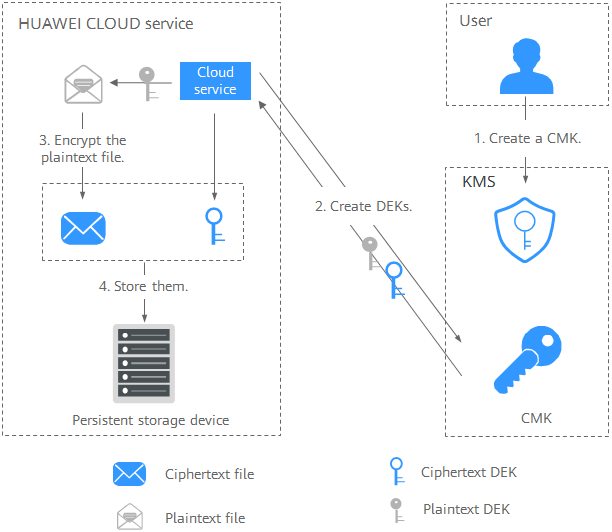Using KMS for Encryption
Prerequisites
All the custom keys mentioned in this section are symmetric keys. For details about symmetric keys and asymmetric keys, see Key Types.
Interacting with Huawei Cloud Services
Huawei Cloud services use the envelope encryption technology and call KMS APIs to encrypt service resources. Your CMKs are under your own management. With your grant, Huawei Cloud services use a specific custom key of yours to encrypt data. For details about cloud services using KMS for encryption, see Cloud Services with KMS Integrated.

- Create a custom key on KMS.
- Huawei Cloud services call the create-datakey API of the KMS to create a DEK. Then you get a plaintext DEK and a ciphertext DEK.

Ciphertext DEKs are generated when you use a CMK to encrypt the plaintext DEKs.
- Huawei Cloud services use the plaintext DEK to encrypt a plaintext file, generating a ciphertext file.
- Huawei Cloud services store the ciphertext DEK and ciphertext file in a persistent storage device or a storage service.

When users download the data from a Huawei Cloud service, the service uses the custom key specified by KMS to decrypt the ciphertext DEK, uses the decrypted DEK to decrypt data, and then provides the decrypted data for users to download.
Working with User Applications
To encrypt plaintext data, a user application can call the necessary KMS API to create a DEK. The DEK can then be used to encrypt the plaintext data. Then the application can store the encrypted data. In addition, the user application can call the KMS API to create CMKs. DEKs can be stored in ciphertext after being encrypted with the CMKs.
Envelope encryption is implemented, with CMKs stored in KMS and ciphertext DEKs in user applications. KMS is called to decrypt a ciphertext DEK only when necessary.
- The application calls the create-key API of KMS to create a custom key.
- The application calls the create-datakey API of KMS to create a DEK. Then you get a plaintext DEK and a ciphertext DEK.
- The application uses the plaintext DEK to encrypt a plaintext file. A ciphertext file is generated.
- The application saves the ciphertext DEK and the ciphertext file together in a persistent storage device or a storage service.
Cloud Services with KMS Integrated
KMS provides CMK management and encryption capabilities for cloud services.
|
Service Name |
How to Use |
Reference |
|---|---|---|
|
Object Storage Service (OBS) |
You can upload objects to and download them from OBS in common mode or server-side encryption mode. When you upload objects in encryption mode, data is encrypted at the server side and then securely stored on OBS in ciphertext. When you download encrypted objects, the data in ciphertext is decrypted at the server side and then provided to you in plaintext. OBS supports the server-side encryption with KMS-managed keys (SSE-KMS). In this mode, OBS uses the keys provided by KMS for server-side encryption. |
|
|
Elastic Volume Service (EVS) |
If you enable the encryption function when creating an EVS disk, the disk will be encrypted with the DEK generated by using your CMK. Data stored in the EVS disk will be automatically encrypted. |
|
|
Image Management Service (IMS) |
When creating a private image using an external image file, you can enable the private image encryption function and select a CMK provided by KMS to encrypt the image. |
|
|
Relational Database Service (RDS) |
When purchasing a database instance, you can enable the disk encryption function of the database instance and select a CMK created on KMS to encrypt the disk of the database instance. Enabling the disk encryption function will enhance data security. |
|
|
Document Database Service (DDS) |
When purchasing a DDS instance, you can enable the disk encryption function of the instance and select a CMK created on KMS to encrypt the disk of the instance. Enabling the disk encryption function will enhance data security. |
|
|
Elastic Cloud Server (ECS) |
ECS uses image encryption or data disk encryption to encrypt ECS resources.
|
|
|
Scalable File Service Turbo (SFS Turbo) |
When creating an SFS Turbo file system, use the key provided by KMS to encrypt the file system for core data security. |
|
|
FunctionGraph |
To decrypt sensitive data, such as database passwords and API keys, during function runtime, you can use the KMS SDK to dynamically operate keys. You can host encryption and decryption keys in KMS and create an agency in IAM for FunctionGraph to access KMS. |
|
|
Cloud Operations Center (COC) |
COC uses KMS to encrypt your host accounts for better security. Before using KMS, create a key first. |
|
|
Cloud Data Migration (CDM) |
When migrating files to a file system, CDM can encrypt and decrypt the files using the keys provided by KMS. |
|
|
Data Security Center (DSC) |
You can use the encryption algorithms and encryption master keys to generate an encryption configuration for data masking. |
|
|
Workspace |
You can use the key provided by KMS to encrypt disks when purchasing a workspace. |
|
|
GeminiDB |
You can use the key provided by KMS to encrypt static data in the database when purchasing a GeminiDB instance. |
Feedback
Was this page helpful?
Provide feedbackThank you very much for your feedback. We will continue working to improve the documentation.






